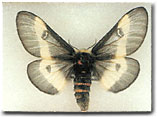Species of Concern/Protected Species
THE BARRENS BUCKMOTH : A Species of Concern Protected by an Orenda sanctuary

The barrens buck moth, Hemileuca maia maia, is listed as a threatened species in the MA Heritage and Endangered Species Program, as only fourteen state occurrences have been verified and documented since 1978 (Anonymous, 1994). With a large (2″) and bold wingspan, this member of the giant silkworm family (Lepidoptera: Saturniidae) is nevertheless a conspicuous late season, day-flying moth (see Figure 1) that may be observed during buck deer season, hence the common name. Wings are translucent, a dark border interrupted by a white band, then dark again to a black and red hirsute body. The male barrens buck moth, distinguished by a red abdominal tuft, uses a pair of pectinate, or feathery, antennae to recognize the sex perfume, or pheromone of the female moth. Mated during the early autumn months, the female then rings one or two masses of eggs around branches of a host plant. Ova are protected by waterproof shellac secreted by the moth and spend the winter on the dormant branch; soon after their mating, female moths perish, but males may continue their mating quest for a short period. As with many saturniid adults, mouthparts are non functional and no food is ingested during the adult stage.
Buck moth caterpillars hatch in late May/early June the year following oviposition. Their behavior is curious, as hatchlings dine on foliage of their principle foods, the scrub oak (Quercus ilicifolia) and dwarf chestnut oak (Q. prinoides) in a gregarious manner. That is, they aggregate on a single plant during much of their immature lives, leaving only later to disperse and continue feeding on a wider host range, prior to pupation. The quiescent pupal stage occurs underground; although a short percentage of pupae remain interred for several years, most adults emerge a few months later to complete the life cycle.
Larvae are dark and spiny; the spines are said to be urticating, or venomous to a touch, and can produce swelling to an unfortunate finger or hand. Larval coloration is variable, from black to a cream, with caterpillars dappled in yellow specks (Wagner et al., 1997). Upon hatching, the minute caterpillars become eating machines, devouring host foliage, munching edgewise to the mid rib.
The gregarious nature exhibited by the hatchlings must prompt speculation. Perhaps the darkened, massed bodies absorb extra spring sunlight, warming each crowded individual, raising the ambient micro-temperature to a more comfortable level. Communal feeding behavior may enhance survival of the offspring, with strength seen in their distasteful numbers; whereas an avian predator might pick off a single wriggling worm, a writhing mass of spines may seem unpalatable.
The range of this species is north to Nova Scotia, south to Florida and west to Colorado, but never beyond the Rockies (Berenbaum, 1993). Among these areas, the usual habitat is the pitch pine-scrub oak barrens fastened in sandy soil, but barrens buck moth populations seem to prefer the oak species complement and may be observed there. Of note is the fragile nature of this transient territory. Much habitat is lost due to uncompromising development, particularly in southeastern Massachusetts, and fragmentation of tracts of barrens may deter the buck moth life history. Events of succession can also contribute to the threatened status of the buck moth. Indeed, the practice of prescribed burning is critical to management of the pine-oak barren, as fire intolerant species will shade out the smaller pine and oak, succeeding to an environment unsuitable for buck moth survival. These factors all align against the buck moth, and thus habitat conservation is critical to continuance of this lovely and unique species.
References
Anonymous, 1994. Threatened Species of Massachusetts. Natural Heritage & Endangered Species Program
Berenbaum, M. 1993. Ninety-nine more maggots, mites and munchers. University of Illinois Press, Urbana and Chicago.
Wagner, D.L., V. Giles, R.C. Reardon and M.L. McManus. 1997. Caterpillars of Eastern Forests. United States Forest Service Publication FHTET-96-34. (Photographs courtesy of Dr. David Wagner, University of Connecticut, Storrs, CT)
